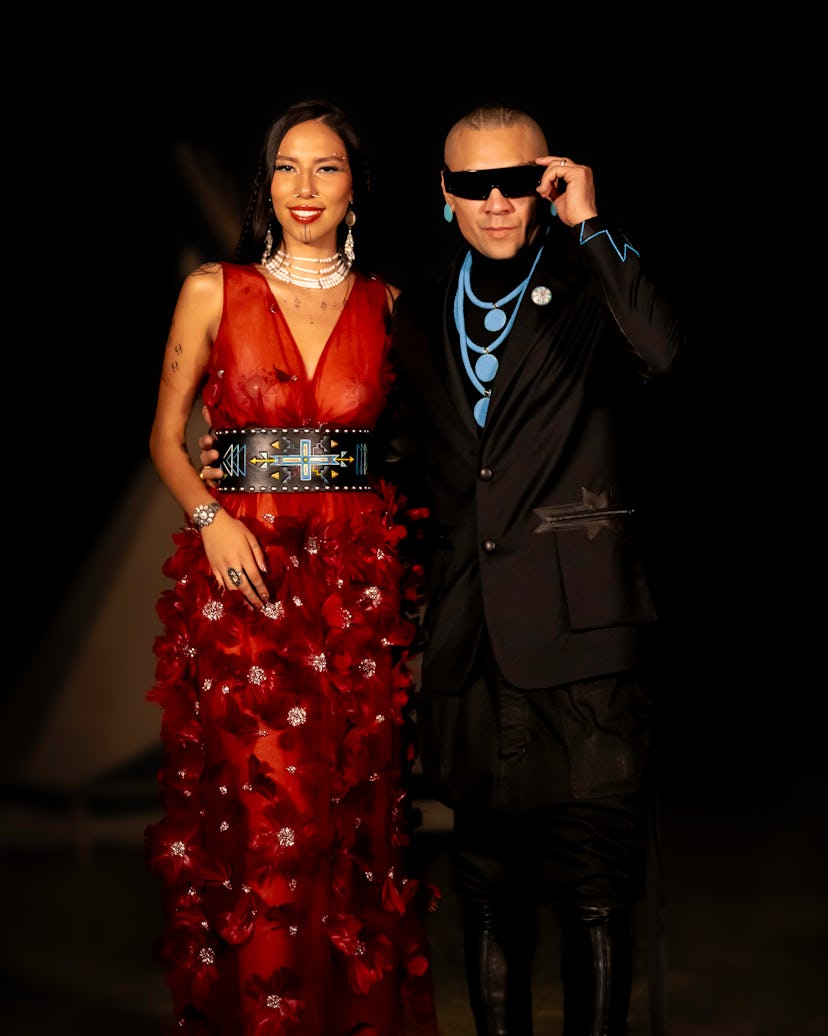On Saturday, October 12, Native American fashionistas gathered at Los Angeles’s Autry Museum for a first-of-its-kind fete coinciding with Indigenous Peoples’ Day Weekend: the Indigenous Fashion Collective’s inaugural gala. Co-chaired by activist/model Quannah Chasinghorse (Hän Gwich’in and Sičangu/Oglala Lakota) and Black Eyed Peas rapper Taboo (Shoshone/Hopi/Mexican), the high-profile event is being dubbed the “Indigenous Met Gala.”
“We wanted to bring our people together in a really big, beautiful way and show the world how impressive and elite Indigenous artistry is,” said Chasinghorse, who in recent years has risen to fame walking the runway for top fashion houses such as Chanel, Chloé, and Ralph Lauren. “It’s about taking control of our narrative and reclaiming our own spaces. We belong in the world of high fashion, even though we’ve never been included—until now.”
Under the theme of “Still Here, Still Vibrant: Indigenous Couture Shaping the Future,” the posh affair showcased Native culture and creativity in its most fashionable forms. To kick off the evening, Indigenous luminaries like the event’s co-chairs, Reservation Dogs breakout actor D’Pharaoh Woon-A-Tai (Anishinaabe), and Dark Winds stars Zahn McClarnon (Hunkpapa Lakota) and Kiowa Gordon (Hualapai) graced the turquoise carpet. Many of them donned couture creations by featured designers Tierra Alysia (Kashia Pomo), Jason Baerg (Red River Métis), Orlando Dugi (Diné), Lesley Hampton (Temagami First Nation), Jontay Kahm (Plains Cree), Kayla Lookinghorse (Standing Rock Sioux Tribe), and Patricia Michaels (Taos Pueblo).
Kate Nelson, Wabanoonkwe Irick, and Lillian Sparks Robinson at the Indigenous Fashion Collective Gala.
Taboo and PJ Vegas at the Indigenous Fashion Collective Gala.
The special occasion served as the official launch of the Indigenous Fashion Collective, cofounded by Lakota matriarchs Sarah Eagle Heart, Lillian Sparks Robinson, and Twila True earlier this year. The member-based nonprofit organization is on a mission to increase Indigenous presence in the fashion industry, while also creating sustainable economic opportunities.
“In the past few years, we’ve seen Indigenous fashion bubbling up as this very exciting industry, with Native designers, models, and photographers coming to the forefront,” Eagle Heart, who currently serves as the collective’s interim executive director, said. “My co-founders and I saw this as an area that needs investment in order to help Indigenous entrepreneurs develop their businesses, while also educating big brands on what it means to support our culture and our creativity. Rather than waiting to be invited to the table, we’re creating our own table and inviting everyone to join us.”
For designer Lookinghorse, the gala was a momentous occasion. “To be a part of the first Indigenous Fashion Collective gala felt so iconic,” said the Southampton, New York–based designer. “The collective is a testament to the remarkable resilience of Native peoples.”
The event also served as a reunion of sorts, given the tight-knit nature of the Native community. After mixing and mingling during cocktail hour, guests savored a multicourse Indigenous-focused dinner prepared by acclaimed Potawatomi/Mexican chef Pyet DeSpain, who has a limited-run residency at Abernethy’s in downtown Los Angeles through spring 2025. Guests noshed on dishes like braised bison, maple thyme-glazed salmon, and mushroom wild rice, while activist/DJ Emcee One curated the evening’s soundtrack.
The room was buzzing with electric energy and enthusiasm. Excitement reached a fever pitch when the awards program began, recognizing notable achievements in fashion and jewelry design, modeling, beauty, and more. Chasinghorse presented the Indigenous Model of the Year Award to friend and colleague Phillip Bread (Comanche/Kiowa/Blackfoot), explaining that he has been instrumental in carving out space for Indigenous talents in the fashion world. In accepting the accolade, Bread thanked his family and the support network surrounding him—including many people in that very room.
From left: Eugene Brave Rock, Frances Fisher, Zahn McClarnon, Audra Wise, and Kiowa Gordon.
Lookinghorse was also among the honorees that evening, receiving the Emerging Indigenous Designer of the Year Award presented by Taboo, who met her at the famed SWAIA Indian Market this summer and was impressed by her commitment to her craft and her community. For her, fashion acts as an opportunity to both fight historic stereotypes about Native peoples and to forge a path toward the future.
“We are no longer black-and-white memories, as history would have us remain,” Lookinghorse said. “Indigenous fashion is breaking free from traditional constraints, so we can continue to innovate with concepts directly connected to our rich cultures. My hope is that more people start to understand fashion from a first peoples’ perspective, since we’ve long been at the forefront of inspiration, sustainability, and luxury.”
After the programming concluded, attendees made their way to the Autry’s alfresco courtyard for an intimate concert featuring Taboo, Emcee One, and PJ Vegas (Yoeme) with entertainment by Lumbee hoop dancer Eric Michael Hernandez. Guests danced the night away in their finery under the stars, with a full understanding of the magnitude of that moment.
Quannah Chasinghorse
In addition to amplifying Indigenous couture, the collective aims to create meaningful change by helping Native designers, models, photographers, and hair and makeup artists break into the fashion industry. To that end, the festivities extended to Indigenous Peoples’ Day on October 14 with a full schedule of educational sessions, including a modeling symposium led by Chasinghorse herself. The rising star shared her expertise, insight into her own experiences, and her hopes for the future.
“I want to see more Native people in the fashion world, because we deserve to be there,” she says. “When I got signed [to a modeling agency], I had no idea what I was doing. I want to share my knowledge and my resources so aspiring Native models can take up space with confidence. Growing up, none of us saw real Indigenous representation, and now that we’re seeing it, it helps our [Native] youth realize they can have a life outside their rez or village.”
